THE DELUDED PERSON AS AN ACTOR IN AN ABERRANT SCENARIO
Abstract
The paper develops the idea of interpreting delusion based on Gallagher's “multiple realities” perspective. The self is considered to be permanently involved in different scenarios, including fictional ones, such as watching a play or reading a novel. The narrative theories of personality also discuss the involvement of the self in various scenarios, but with the possibility of returning to its basic, biographical identity. Delusion is interpreted as a “fall” in a role of an aberrant scenario, which the subject cannot escape from. The multiple realities are discussed from Mircea Eliade's perspective regarding the sacral time of the myth that forms the background for the time and structure of the fictional narratives. The normal psyche is characterized by a meta-representational structure, which allows the self to play the roles in different life scenarios. Delusion is interpreted as the alteration of the “autonoetic consciousness” and of the “mental time travel” structure
INTRODUCTION
Delusion is still defined by reference to Japers (1997), who considered it an abnormal, incomprehensible belief in a false idea, which takes place through a psychopathological process. In a manual of descriptive psychopathology, it is stated that:
“For Jaspers, the characteristics of delusions are that: (a) they are false judgements, (b) they are held with extraordinary conviction and incomparable subjective certainty, (c) they are impervious to other experiences and to compelling counterargument and (d) their content is impossible” (Oyebode 2008, 122).
During the last decades, there has been an increasing number of psychopathological studies regarding delusion, especially due to the development of cognitivism. The “top-down” and “bottom-up” theories consider delusion a false belief (Bertolotti 2010). Lately, this thesis was frequently argued (Stephens 2009). Recently, Gallagher (2009) suggested another approach of delusion, from the perspective of “multiple realities” (MR). He stated that the person is living in various realities in his everyday life, for example when going to the theatre, when reading a novel or when playing a video game. These realities are different from the practical reality of the everyday life. So is delusion, which absorbs the subject in a particular reality. Still, when living in the “multiple realities”, the normal subject is able to return to his normal life.
We will try to develop Gallagher’s hypothesis starting from the perspective of the narrative psychology of the person, referring to the special temporal dimension of the narrative reality and considering the particular domain of the sacral myth. For this purpose, we will discuss Mircea Eliade’s interpretation of the special temporality of the myth and of cultural narrativity.
DIFFICULTIES IN THE STUDY OF DELUSION
Before presenting our own thesis, we will shortly highlight four problems which make the study of delusion difficult.
The first difficulty lies in the fact that delusion is part of multiple clinical contexts. We consider that, from a psychopathological perspective, the delusion which characterizes the “Persistent delusional disorder” in ICD 10 (F22) (WHO 1992) is more relevant to our purpose than the schizophrenic delusion.
A second aspect concerns the frequent correlation between delusion and different perceptive disorders, such as the “salience” phenomenon, illusions, hallucinations, derealization, sensitivity, “centrality”, reference. These inferences draw attention to the fact that the psychic structure disturbed in delusion is a trans- situational one, implying a meta-representational level.
The third problem implies the various notions used to characterize delusion, in different domains. We can mention some of them: belief, truth, evidence, doubt, certainty, idea, experience, argument, proof, faith, conviction. These terms are also used in philosophy. The ancient skeptics talked about “doubt” and so did Descartes. The concept of “idea” was mentioned by Platon, later by Kant and it currently has different meanings.
The fourth difficulty is related to the classical problem of the primary delusion. In his main article in 1910, Jaspers made a difference between the abnormal, but comprehensible prevalent process and the incomprehensible primary delusion (Jaspers, 1963). The primary delusion emerges in a different way, being preceded by a delusional mood. The subject feels that everything around him has a special, mysterious significance related to him (the feeling of “centrality”). At a certain moment, a common perception receives a special meaning and “clarifies” the delusional, incomprehensible theme (delusional perception). It is the moment when the “psychopathological process” takes place and “moves” the subject on the incomprehensible orbit of the primary delusion.
However, the clinical experience proves that a progressive variant of the emergence of delusion is also possible, even in the case of the delusion of jealousy. For example (a personal case):
“A 35 years old man progressively gets to the conclusion that his wife is cheating on him with her boss, with all her colleagues and, later, with all the members of the administrative community of the town. For this reason, they move to a different city. There, the history repeats itself. The situation becomes unbearable, because people start to laugh at him on the street. After moving to another place, having the same problems, the man accepts the admission in a psychiatric unit, 4 years after the onset.”
The delusional jealousy and the transition from normal jealousy to prevalent and delusional ideas have been studied by many authors (Shepherd 1990, Enoch
1991). All of them agreed that a progressive evolution towards delusion can characterize jealousy; and also dysmorphophobia, hypochondria or the ideas of reference, as classically described by Kretschmer (1974). Two decades ago, Hollander (1993) suggested a possible obsessive-compulsive spectrum and imagined a continuum between the pole of obsessive uncertainty and the one of delusional certainty, passing through the over- evaluated ideas; the anxious-phobic phase could be placed at the beginning of this continuum (Fig.1).
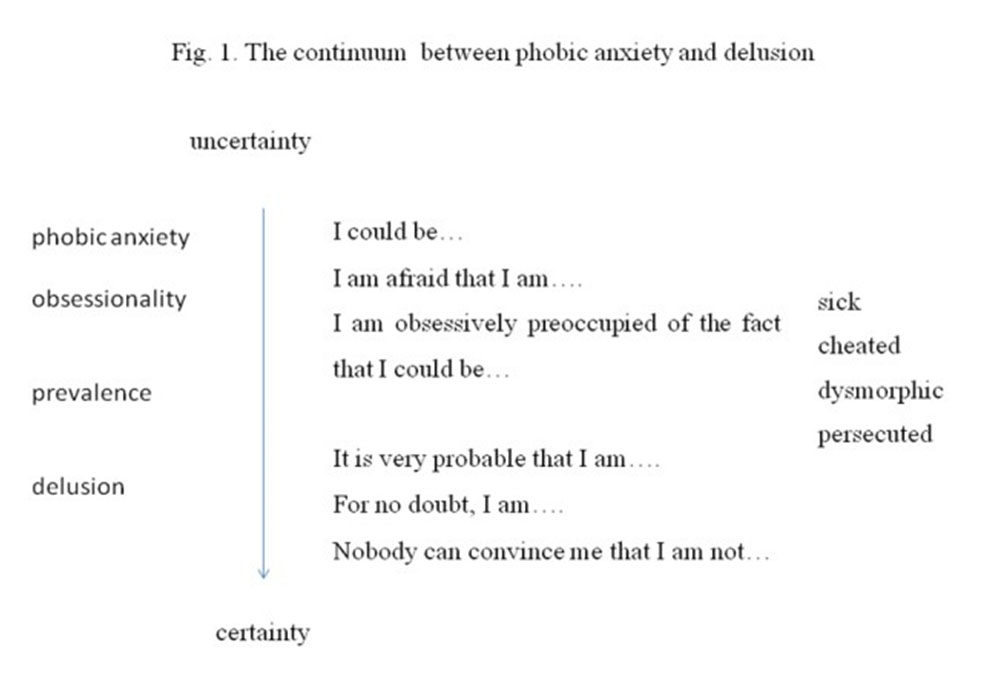
Although we agree with the idea of the continuum, we also need to accept the idea of a “disruption” or “fall on another orbit” in the case of delusion (Fig.2).
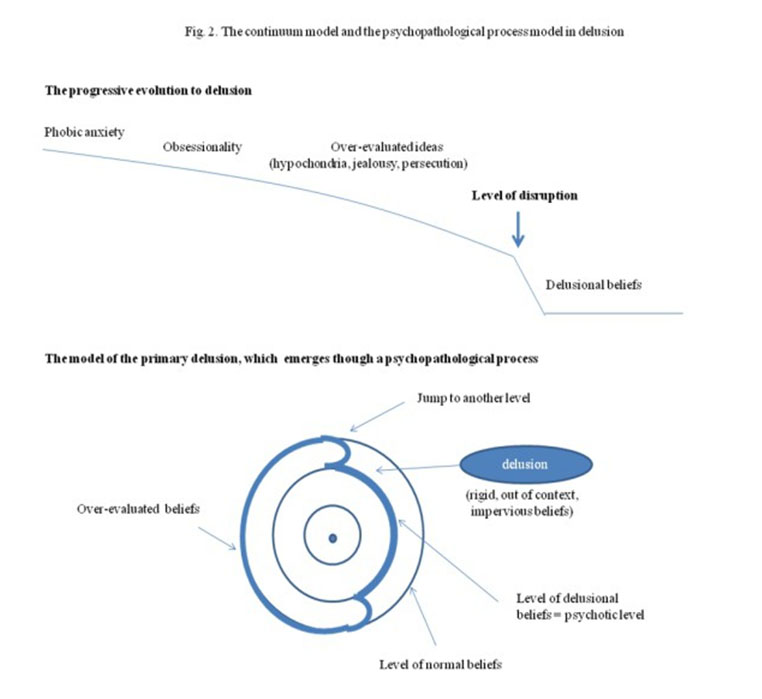
The slowly progressive emergence of delusion and the sudden occurrence of the primary delusion are complementary. The last one is important for understanding delusion, because it highlights the existence of a psychotic level. This level can be considered similar, but specifically different, from the psychotic level of mania, major depression, depersonalization, disorganization, catatonia, obsessionality etc. The question would be: what is the psychic structure – centered by the self – which is impaired in this case of “psychosis’ in general and in the case of delusion in particular?
PERSONAL THESIS
Our own thesis states that delusion can be characterized by an abnormal identification of the subject with a special role in a narrative scenario, a real or a fictional one. This scenario refers to the subject’s identity, including: his state of being, his value, relationships, situation or his own self. For example: the role of a sick, dysmorphophobic, spied, persecuted, over-capable, guilty, incapable person, the role of someone who has a special mission given by God etc. The presence of a narrative scenario leads us to the “multiple realities” described by Gallagher.
F r o m a p h e n o m e n o l o g i c a l – e x i s t e n t i a l i s t perspective, the deluded person can be compared to an actor playing the role of King Lear or Othello. In the same way, an obsessive person is similar to someone who is permanently preoccupied with the construction and cleaning of a house and a manic person with someone who takes part in a New Year’s Eve carnival. The obsessive person becomes deluded only if he enters the role of a person who is in great danger of contamination or who is guilty for a possible danger produced by his magical thinking. Similarly, the manic person becomes deluded only if he takes the role of a character who is solving the world crisis or who has the mission of saving humanity; thus, who is transposing himself into a narrative scenario.
Our thesis highlights that the “idea” lying in the center of the delusional belief is characterized by an identitary role in a narrative scenario. This approach leads to Tomkins’ narrative psychology. Tomkins, cited by McAdams (2008), suggests that the person is continuously generating dramatic scenarios for the problematic situations of his everyday life. He is the author and the actor in these scenarios. In normality, he is permanently part of various scenarios with different durations. He can evaluate their importance and can get out of them whenever he wants to. But he is constantly maintaining his biographical self identity, his agency and the ownership of his creativity regarding the events in which he is involved. Narrativity is both implicit and explicit. Personal narrativity implies the use of language and expresses itself through different imaginary scenarios, dialogues with oneself, biographic reports, potential or real narrations of situations and events. All these can be narrated in different ways and moments by other people or by the subject, as memories. They can be studied systematically, as McAdams’ narrative psychology did, for example. By playing different roles in multiple narrative scenarios, the subject is living on various levels with different objectives and different durations. This aspect is related to the study of the “mental time travelling” function, in relation to Tulving’s autonoetic consciousness (1983). The subject expresses himself through a variety of selves, on the background of a basic biographical identity and time. Hermans has also studied this aspect (2009), based on James’ ideas of the multiplicity of selves (1996).
In the case of delusion, a certain scenario becomes dominant. The subject collapses in a specific role, which merges with his own identity. The person’s receptivity and creativity for the involvement in other scenarios decrease. The aberrant scenario is lived by the subject in relation to the real world or to a fictional one. E.g.:
“A patient shoots another person believing them to be an enemy assassin and himself to be the Queen’s personal bodyguard”. (Oyebode 2008, 122).
“A manic patient claimed to be Mary, the Queen of Scots. She accepted that the queen in question lived and died centuries ago but claimed descent from her and felt fully entitled to say that she was she” (Oyebode 2008, 126).
A patient explains that “everyone smiles and nods when they see me because I have been sent by God to communicate with people about evil and I have a letter from the Pope as proof”. (Oyebode 2008, 134).
Understanding the delusional idea as the placement of the subject in an aberrant identitary- relational role in a narrative scenario is consistent with Gallagher’s point of view. He interprets delusion from the perspective of multiple realities (MR). Gallagher (2009) goes further with Shultz’s interpretation of James’ concept of “sub-universes” and discusses the realities which are different from the everyday life: the reality lived when going to the theatre, to the cinema or when playing a video game. The subject can temporarily enter the role of the characters of these realities and can take part of their adventures. Similarly, in his dreams, he becomes the hero of some particular events. Still, in normality, the subject is in permanent contact with the everyday events and he can always return to his real life after spending time in the fictional or virtual reality.
We believe that Gallagher’s idea deserves to be analyzed and developed. It implies the evaluation of the identitary roles from the aberrant scenarios of the delusional sub-universes and an analysis of these multiple worlds. It highlights the psychological characteristics of the person living in the realities of the theatre plays, novels, stories, myths or games. In relation to these realities, we can better understand the subject’s “fall” in the abnormal situation of “being in the world”, in a parallel reality than the one of everyday life; a reality which absorbs him and which he cannot abandon on his own.
THE PROBLEM OF THE MULTIPLE REALITIES
The deluded person „falls” in a special world, parallel to the many worlds which form the „socio-cultural realities” (SCR). When analyzing delusion, psychopathology needs to take into account not only the impairment of the psychological processes (perception, cognition, ideation, memory, representation, imagination, will, motivation, expectancy, evaluation, belief etc), but also the realities of the multiple human worlds, formed by novels, theatre, history, myths, in which the person lives during his life. The SCR become part of the individuals through the process of education.
The subject has at his disposal the „multiple realities” (MR) and he is permanently connected to them in his everyday life. He can enter these realities if he needs or if he wants to (Table 1).
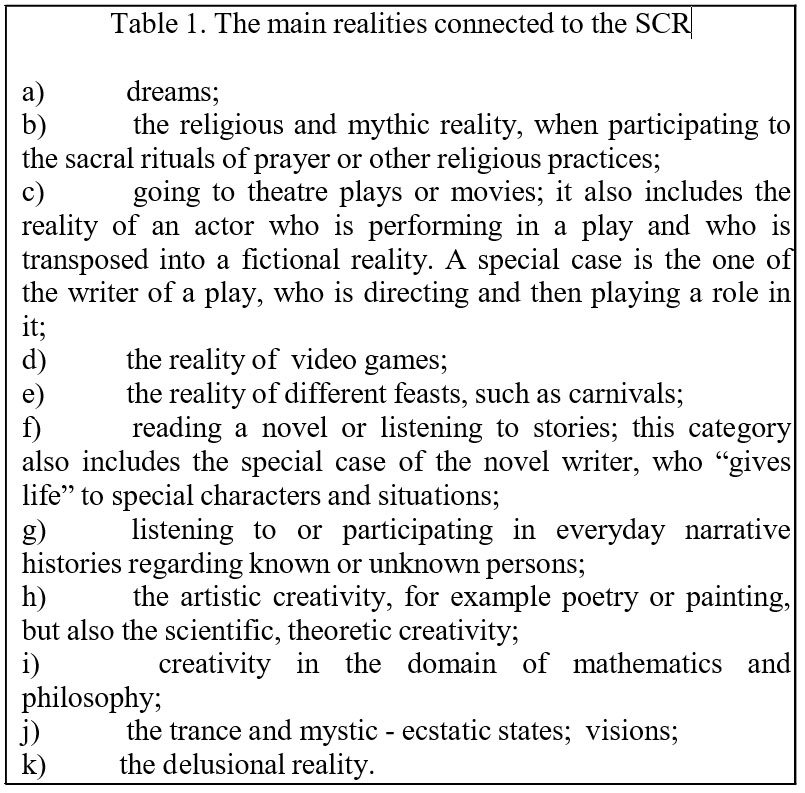
The most important themes related to delusion are the c),d),e),f),g) and partially a) situation. The b) and c) situations are related to mania. The h),i).j) situations are especially important for schizophrenia. The a) situation is met in delirium and may have some correlations with delusion.
Some of these more or less “fictional” realities are common for everybody. However, there is no operational definition for the normality of the persons who are involved in these realities. The normal person takes part in these realities with his whole cognitive and imaginative functions, in a special existential temporality, during his entire life.
The discussion of the dream in this context is important for highlighting the personal and subjective character of the states we describe in our thesis. All these realities involve the “subjective world” of the person. Dreams are present in a different reality than the one of the physical and bio- psycho-cultural human world. However, they derive from the everyday life. This aspect reveals the fact that, in all the “sub-universes” of the SCR, the subject partially detaches from the environment and his availability for connecting to the world is temporarily limited. When watching a play or while reading a book, the subject does not think about something else. He is “isolated”, but, in the same time, he remains connected to the SCR. This connection is also present in the case of creativity (h) and i) situations).
The subject is involved in different scenarios and roles not only by entering the multiple realities which are parallel to the SCR. He is also playing these roles inside the SCR, during his everyday life.
The sociology of the 20th century has developed the concepts of “social status” and “social role”. These concepts apply to the family institution as well. The person can have different statuses: engaged, married, divorced, widowed etc. and, in the same time, he has different roles: the role of a parent, child, relative etc. Another perspective of the individual roles considers the “dramatic” process of human existence. People fall in love, they get married, they argue. Children are planned, born, they grow up, they have their own families, they build a house etc. The old person retires, has a will, and leaves behind a material and spiritual heritage. All these processes and events are in a continuous development, but they can also be narrated as part of the personal biography. The events which happen in real life are similar to the ones happening in a play or a novel. For example, a husband can be jealous in the real life, but also in a tragedy. The exaggerated preoccupation for illness, erotomania, persecution or the will for harming someone are realities of the SCR, but can also be present in the fictional narrative realities of the movies or novels. Everyone is permanently playing the social roles of the cultural society he lives in. But these scenarios are part of the subject only to a certain level of his psychic structure. From the level of social roles, the subject can “slip” to the delusional “sub- universes”.
If we consider the MR concept and the delusion viewed as an aberrant involvement of the subject in a certain “sub-universe”, we need to ask ourselves: what is the basal ontological structure of these human “sub- universes” or “sub-realities”? For understanding these realities, we suggest a model based on the special narrative temporality of the sacral and profane worlds, described by Mircea Eliade. The narrative time of the myth which evokes the origins of the world is different than the narrative time of the profane actions. The sub-universe of the human practices, as well as the one of the novels, could be explained from this perspective.
In his classical books “Treaties on the history of religions” (1987) and “The myth of the eternal return” (1971), Eliade analyzes the fact that the whole human history has been structured by the polarity between the sacred and the profane. In every culture (until the end of modern era), there has been the belief that the unnatural forces had created the world in the holly time of beginnings. The sacral practices, the rituals and religious ceremonies are an important part of human existence. People use the sacral rituals in order to invoke the time of beginnings. They tell the mythic stories in a special place and time. In the same way, the legends and histories of a community draw the people out of the time and space of the everyday preoccupations. By listening to these stories, they ignore the reality of the present time and they are placed in a different time, the one of the “once upon a time” narrations. Besides the present “reality” of the environmental world, people also live in the temporality of other narrative realities. The paradigm of these temporalities is the originary time of creation. Eliade believes that this model can also be applied to the special reality of literature.
In his book “Aspects of myth” (1963), published in the USA, Eliade discusses the fact that people need the “stories” and they need to enter the foreign universes created by stories. It is part of the human condition. Every person is fascinated by different narrations, by the stories of historic or literary characters. Reading a novel or a history implies the exit from the time of the everyday life. A comparison can be made to the traditional societies’ practices of reciting a myth. In both situations, the person “is getting out of” the personal and historical time and he is entering a fabulous, trans-historical time. The reader is placed in a foreign, imaginary time. Thus, the novel has access to the primary time of the myths.
The immersion in a delusional state and in a fictional delusional scenario can be compared to the normal, periodical entering of any person in the narrative time of a novel or a religious ceremony. Each person is living in the “multiple realities” that have their own specific time. The difference is that the deluded person “is falling” and is “locked” in his fictional, absurd scenario. The patient acts according to the rules of this particular reality and he is not able to get out if it. The delusional world is simplified, rigid, inflexible and the complex temporal structure of the person is blocked. The identitary self is the main structure which is impaired in the delusional pathology. The deluded person over-identifies himself with his aberrant role. On the contrary, in the case of the shizo-hebephrenic disorder of the self, described by Minkovski (1927) and Parnas (2011), this thing is not possible any more. That is why the schizophrenic delusion is bizarre and depersonalizant.
This interpretation of delusion implies the problem of narrativity and human language. Thus, it is correlated with Crow’s approach of psychosis, who considers that schizophrenia is a price paid by evolution for the development of language, 150000 years ago.
D E L U S I O N A N D T H E M E T A – REPRESENTATIONAL LEVEL
We cannot describe the correlation between delusion, narrativity and temporality without considering the psychological structure where this process develops.
. It needs to be a representational and meta- cognitive structure, which is connected to the narrative biographic identity and also with the situational experiences of the person, which have different temporal durations. This meta-representational structure is connected to the narrativity of the multiple realities we have described. The subject is permanently evaluating the situations in a meta-cognitive way. He is imagining problem-solving scenarios, based on probabilistic models. These scenarios also refer to his long-term relationships, to identitary and self-evaluation aspects. Besides the present situation, the self is also part of various projects of different durations. Tulving’s model of the Mental Time Travel can be mentioned here.
We suggest the following model of the self as a whole (Fig. 3).
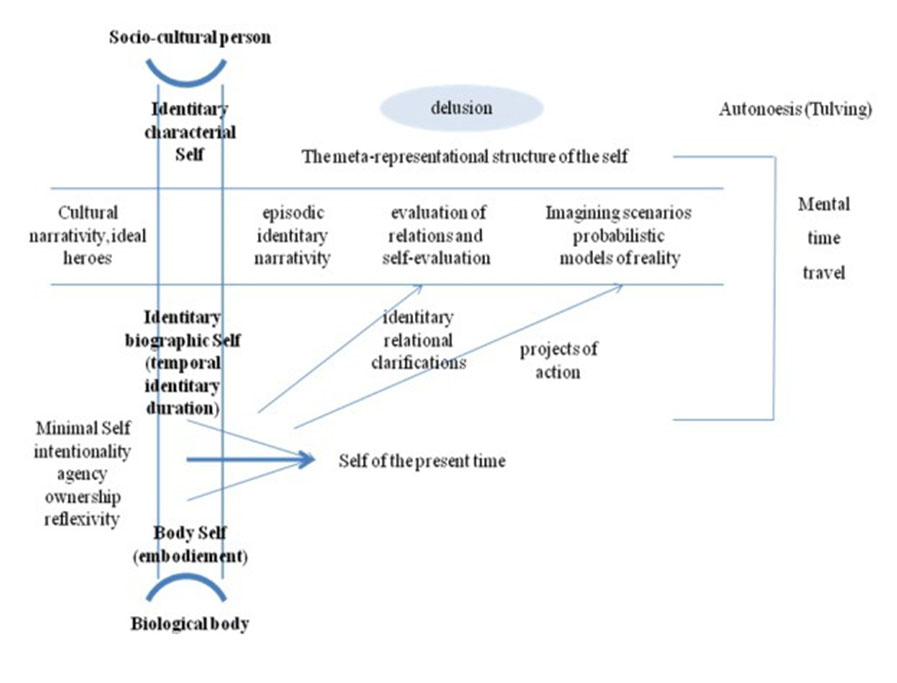
In delusion, the meta-representational structure of the psyche involves the subject in the role of a hero in different scenarios which takes him out of the context. The meta-representational structure can also be involved, in a different way, in the mood and obsessive-compulsive disorders (Fig. 4).
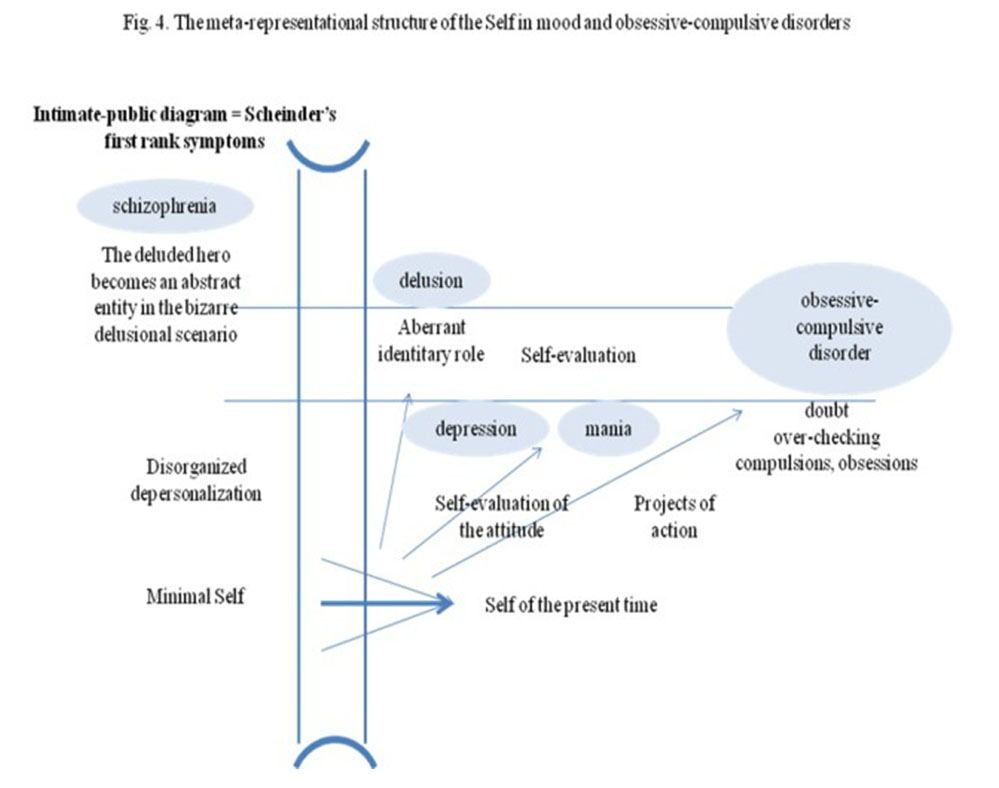
In the schizophrenic delusion, the subject is depersonalized, so that the hero in the delusional scenario becomes an abstract entity, almost completely absorbed in fiction. Schizophrenia is based on the pathology of the minimal, nuclear self and not the one of the biographic, narrative self which places the subject in different social roles. Through the collapse of the intimate-public relational structure, the self loses his autonomy. This aspect is expressed by Schneider’s first rank symptoms. That is the reason why the schizophrenic delusion is only one special, atypical form of the delusional pathology. From this perspective, the “primary delusion” discussed by the psychopathologists in the last decade might not be the ideal model for the study of the delusional pathology.
CONCLUSIONS
The interpretation of delusion as the “fall” of the person in a role of an aberrant, rigid and fictional scenario, from the perspective of multiple realities, represents an idea which deserves to be debated and studied in the future.
REFERENCES
1.Bertolotti, L. 2010. Delusions and other irrational beliefs. Oxford: Oxford University Press.
2.Eliade, M. 1963. Aspects du mythe. Gallimard.
3.Eliade, M. 1971. The Myth of the Eternal Return: Cosmos and History. Princeton: Princeton University Press.
4.Eliade, M. 1987. Traité d’histoire des religions. Paris: Payot.
5.Enoch, D. 1991. Delusional jealousy and awareness of reality. British
Journal of Psychiatry, no. 159 (Suppl 14): 6-13.
6.Gallagher, S. 2009. Delusional realities. In Psychiatry as Cognitive Neuroscience. Philosophical perspectives, ed. M. Broome, L. Bortolotti, 245-268. Oxford: Oxford University Press.
7.Hermans, H. 1996. Voicing the Self: From Information Processing to Dialogical Interchange. Psychological Bulletin, no. 119:31-50.
7.Hollander, E. 1993. Obsessive-Compulsive Related Disorders. Washington: American Psychiatry Press.
8.Jaspers, K. 1997. General Psychopathology. Baltimore and London: Johns Hopkins University Press.
9.Jaspers, K. 1963. Eifersuchtswahn, ein Beitrag zur Frage: Entwicklung oder Prozeß. In Gesammelte Schriften zur Psychopathologie, ed. K. Jaspers, 85-141. Berlin: Springer Verlag. (Original work published in 1910).
10.Kretschmer, E. 1974. The sensitive delusion of reference. In Themes and Variations in European Psychiatry: An Anthology, ed. S.R. Hirsch and M. Shepherd, 157-166. Bristol: John Wright.
11.McAdams, D.P. 2008. Personal Narratives and the Life Story. In Handbook of Personality. Theory and Research, ed. O.P. John, R.W. Robins, L.A. Pervin, 242-264. New York, London: Guilford Press.
12.Minkovski, E. 1927. La schizophrénie: Psychopathologie des schizoïdes et des schizophrènes. Paris: Payot.
13.Oyebode, F. 2008. Sims’ symptoms in the mind: An Introduction to Descriptive Psychopathology, 4th ed. Edinburgh, London: Sauders Elsevier.
14.Parnas, J., and Sass, L.A. 2011. The structure of self-consciousness and the problem of self. In The Oxford Textbook of the Self, ed. S. Gallagher, 521-546. Oxford: Oxford University Press.
15.Shepherd, M. 1990. Morbid jealousy: some clinical and social aspects of a psychiatric symptom. In Conceptual Issues in Psychological Medicine, ed. M. Shepherd, 39-68. London and New York: Routledge.
16.Stanghellini, G. 2000. Disembodied Spirits and Deanimated Bodies: The Psychopathology of Common Sense. Oxford: Oxford University Press.
17.Stephens, G.,L., and G. Graham. 2009. The delusional stance. In Psychiatry as Cognitive Neuroscience. Philosophical perspectives, ed. M. Broome and L. Bortolotti, 193-216. Oxford: Oxford University Press. Tulving, E. 1983. Elements of Episodic Memory. Oxford: Clarendon Press.
18.World Health Organisation 1992. The ICD-10 Classification of Mental and Behavioural Disorders: Clinical Descriptions and Diagnostic Guidelines. Geneva: World Health Organisation.
***



